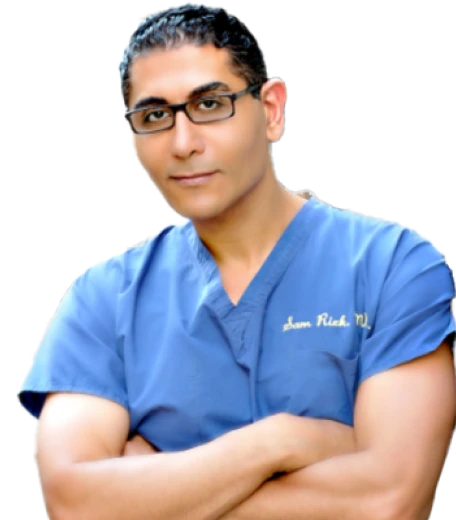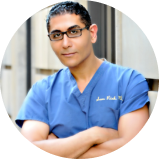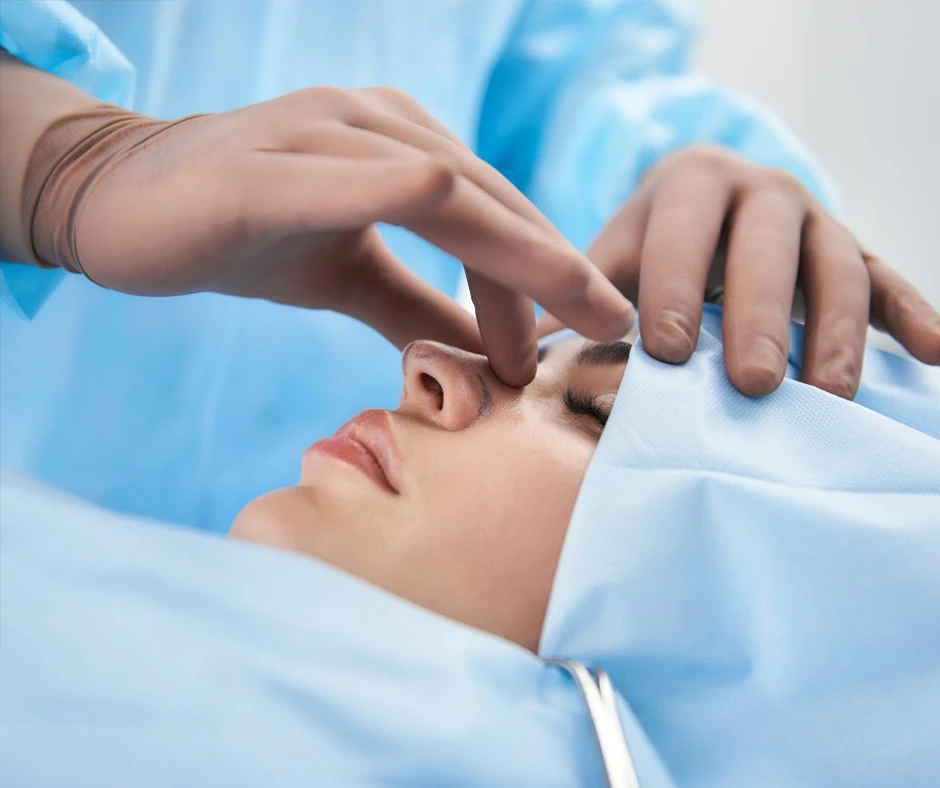Do you dream of having a beautiful, symmetrical nose? If so, rhinoplasty might be the answer. However, before moving forward with this highly delicate cosmetic procedure, it’s important to understand the key differences between the two common types of nose jobs: open and closed rhinoplasty. In this article, not only will we discuss the visual differences between different approaches, but also delve into other essential aspects such as which options present less pain and require a shorter recovery period. Read on to learn more about these two approaches so that you can make an informed decision when exploring your rhinoplasty options!
What Is Open Rhinoplasty?
An open rhinoplasty is a technique that utilizes an additional small incision along the columella (the strip of skin separating the nostrils). Through this incision, Dr. Rizk is able to manipulate and refine the shape and size of your nose with greater precision. This approach allows surgeons to pull back the soft tissue for improved visualization, allowing them to achieve the most aesthetically pleasing result.
What Is Closed Rhinoplasty?
A closed rhinoplasty is a technique that is performed with no external incisions, so all work is done through the nostrils. This approach can be great for those who are looking for more subtle changes and don’t want to have any external scarring. It does, however, limit the scope of what can be achieved aesthetically as surgeons are not able to manipulate the soft tissue in the same detail as an open rhinoplasty technique.
Which Option Is Better – Open or Closed Rhinoplasty?
In truth, there is no one-size-fits-all answer to this question. It will ultimately depend on your individual preferences, as well as the desired outcome you have in mind. However, some general guidelines can be followed when considering the two approaches.
For instance, if you’re looking for more dramatic changes, then an open rhinoplasty may be the best choice for you. This approach is more likely to achieve the desired results, such as a narrower bridge or a smaller tip. However, if you’re looking for subtle changes, closed rhinoplasty may be the better choice as it limits the scope of what can be achieved aesthetically.
When Is Each Approach Typically Recommended?
Dr. Rizk chooses open rhinoplasty (open nose surgery) for three‑dimensional tip sculpting, correcting bulbous tips, prior distortions, crooked bridges, or marked asymmetry. Exposure from a tiny columellar incision enables grafting and robust support, making it invaluable in complex primary and most revision cases.
The closed approach is recommended for first‑time patients seeking modest refinement like smoothing a dorsal hump, narrowing a broad bridge, or fine‑tuning tip definition without major grafting. All incisions stay inside the nostrils, so swelling resolves faster, scars remain invisible, and recovery is shorter.
Advantages and Disadvantages of Open vs Closed Rhinoplasty
When comparing approaches, you may find both advantages and disadvantages to open and closed rhinoplasty techniques. Even the most skilled surgeon finds limits with each approach. Let’s take a look at some of the key benefits and drawbacks below:
Advantages of Open Rhinoplasty
- Provides improved visibility and access to the nose for surgeons, allowing them to make more precise changes.
- Allows for greater capabilities in reshaping the nose.
- Results should be more aesthetically pleasing than those achieved through closed rhinoplasty techniques.
Disadvantages of Open Rhinoplasty
- Requires an additional incision along the columella.
- May be more painful and require more recovery time than closed rhinoplasty.
Advantages of Closed Rhinoplasty
- No external incisions are necessary.
- Less downtime and recovery time than open rhinoplasty techniques.
- Direct exposure of the underlying nasal structure is not necessary, thereby minimizing tissue manipulation.
Disadvantages of Closed Rhinoplasty
- Visibility of the nostril area is limited, making more precise adjustments difficult to achieve.
- Results may be less aesthetically pleasing than those achieved with open rhinoplasty.
Dr. Rizk’s Approach: Open vs. Closed Rhinoplasty
When researching open Vs closed rhinoplasty, remember that surgeon expertise often matters more than incision placement. Double‑board‑certified facial plastic surgeon Dr. Sam Rizk integrates evidence‑based protocols, 3D imaging, and concierge follow‑up to elevate both techniques. Dr. Rizk’s philosophy is not to prefer one approach over the other, but to adapt the surgery to your specific needs, maximizing aesthetic harmony and functional breathing.
The Open Rhinoplasty Approach
Open rhinoplasty uses a small columellar incision to lift the skin, giving Dr. Rizk full 3‑D access for complex structural sculpting.
Microscope‑Level 3D Optics & Ultrasonic Tools
During open rhinoplasty, Dr. Rizk operates under microscope‑quality 3‑D optics and wields ultrasonic sculpting instruments with millimetric‑precision suturing to contour cartilage and bone in layers.
Visibility for Complex Cases
Enhanced visualization lets him place grafts precisely, straighten the septum, and rebuild the tip with minimal bleeding and bruising, especially advantageous for complex primary or revision noses.
Virtually Invisible Scar
Patients often choose Dr. Rizk for his meticulous closure technique, designed so the small external incision heals to near invisibility, delivering dramatic results without obvious signs of surgery.
The Closed Rhinoplasty Approach
Closed rhinoplasty hides every incision inside the nostrils; Dr. Rizk reshapes the bridge and tip endoscopically while preserving ligaments for quicker recovery.
Hidden Incisions & Endoscopic Guidance
In closed rhinoplasty, Dr. Rizk inserts a high‑definition endoscope and custom micro‑instruments through concealed nostril incisions to refine the bridge and tip while preserving key ligaments.
Ligament‑Sparing Recovery Benefits
This ligament‑sparing technique limits postoperative swelling and speeds healing, making it popular among first‑time patients seeking subtle changes and a quick return to daily life.
Preservation Principles for Lasting Results
By honoring the nose’s natural structures, he achieves elegant, long‑lasting results with less swelling and potentially faster recovery.
Recovery Process Comparison
Recovery protocols differ slightly between the two techniques, yet both are optimized in Dr. Rizk’s practice for comfort and rapid healing.
Recovery After Open Rhinoplasty
Given the more extensive nature of this approach, the initial recovery may involve slightly more downtime. The external splint and any sutures are typically removed after one week, but noticeable swelling and bruising may require up to three weeks to substantially resolve. Dr. Rizk’s detailed instructions will guide you on managing this process and caring for the small incision. It remains essential to avoid all strenuous physical activities for 4-6 weeks to allow the underlying structures to heal completely, as the subtle tip refinement continues for several months.
Recovery After Closed Rhinoplasty
One of the primary benefits of the closed technique is a faster initial recovery. As all incisions are internal, swelling and bruising are often less extensive. Following the removal of the nasal splint at one week, many of Dr. Rizk’s patients feel comfortable returning to their social and public activities within 7 to 10 days. Light cardio is allowed at week two, however, despite this quicker initial healing, it is vital to avoid strenuous exercise for the full 4-6 week period to ensure the delicate nasal framework heals without issue.
Conclusion
Rhinoplasty is an incredibly popular procedure that can dramatically improve the shape and symmetry of your nose. The key to Dr. Rizk’s consistently outstanding and natural-looking outcomes lies in his deep mastery of both open and closed surgical techniques. During your consultation, he meticulously explains how each approach relates specifically to your personal anatomy and goals. This ensures the surgical plan is not based on a preferred method, but is perfectly customized to you, creating a pathway to the most stunning and balanced result possible.
If you are considering rhinoplasty, book an appointment with renowned surgeon Dr. Rizk. His wealth of experience and expertise in open and closed rhinoplasty techniques make him the best choice for your procedure.













